The fifth World Nomad Games kicked off this week in Kazakhstan's capital of Astana. Dubbed the "Great Gathering on the Steppe", the Olympics of the nomadic world is a spectacular celebration of traditional sports, identity and culture from across inner Asia.
Part Highland Games, part Mongolian Naadam festival, and featuring sports like horseback wrestling and Central Asian strongman competitions, the World Nomad Games give a flavour of what the Olympics might have looked like if Genghis Khan had been in charge.
Indeed, many of the sports have their roots in the skills required to survive on the steppe and in the unrivalled equestrian abilities that fuelled a millennium-long wave of successive steppe empires, from the Huns to the Mongols. There are traditional events such as archery and long-distance horse races, but the Games also promote Kazakh food, traditional dress and even the art of epic storytelling. The goal is to preserve and protect nomadic and steppe culture, which is under increasing threat from globalisation, modernisation and even climate change.
The World Nomad Games take place every two years and shifts locations as frequently as the nomads it celebrates. The next event in 2026 will likely head back to Kyrgyzstan, where the inaugural event began in 2014. This year's competition concludes on Friday 13 September.
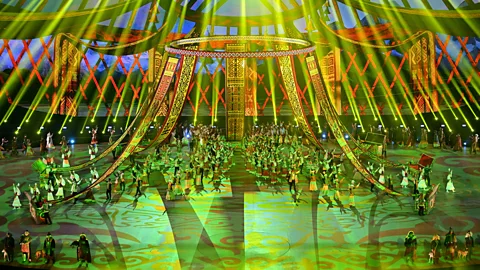 Getty Images
Getty ImagesThe opening ceremony on 8 September was a spectacular affair, with 3,000 athletes from 89 countries filing into the arena, as hundreds of musicians, dancers and singers performed in front of Central Asia's political elite. The show traced the history of the Kazakh steppe from ancient Scythian warriors and Silk Road merchants to the rise of the Golden Horde and the Kazakh khanate in the 15th Century. Performers depicted scenes of the steppe convening under the symbolic embroidered panels of a yurt (pictured above), a reference to the gatherings of nomadic confederations that occurred periodically to enthrone a new khagan (ruler).
 Bradley Mayhew
Bradley MayhewCentral Asia's wildest sport
This Games favourite – known variously across the region as kokpar, kok buru, ulak tartysh and buzkashi – is best described in English as rugby on horseback with a dead goat as a ball.
Two teams of seven horsemen compete to grab hold of the headless carcass (made of rubber for these games), hoist it under their leg, sprint for the opposition's line and then dump it in a ring of rope or a large plastic doughnut. Rough and tumble is putting it mildly; broken fingers and ripped ears are par for the course. "The most important attribute for a kokpar player is to be strong, to be brave and to not be afraid," said the Kazakh team captain, Kermenbek Turganbek.
On Thursday, thousands of fans watched home team Kazakhstan beat arch rivals (and ethnic brothers) Kyrgyzstan in the final in extra time.
An endangered traditional sport
Hunting with eagles is one of the more unusual of the 21 official sports featured in the Games. It takes many years for an experienced eagle hunter (known as a berkutchi) to tame and train a wild golden eagle (berkut), and the expense and time required makes it the most endangered of the Games' traditional sports.
The event has three categories at the competition: hunting with eagles, hawks or falcons. All have their roots in Kyrgyzstan, Kazakhstan and western Mongolia, where the hunting of foxes, rabbits and wolves traditionally takes place in winter when the animals' fur is thickest.
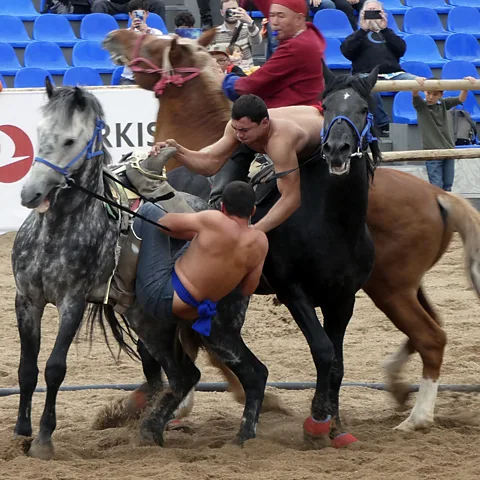 Bradley Mayhew
Bradley MayhewHorseback wrestling
Wrestling on horseback (audaryspak) takes place in a 15m-diameter sandy arena and bouts are divided into six weight categories. The aim is to pull one's opponent onto the ground, but wrestlers can also get points for lifting their opponent from the saddle or pushing them out of the circle. Horses get penalised for biting.
Other forms of non-horseback wrestling (known as kureshi, kurash or koresh in Turkic languages) include specific Kazakh, Turkish, Tatar and Kyrgyz styles, most of which also include female competitions, unlike many of the Games' sports.
 Bradley Mayhew
Bradley MayhewCelebrating a warrior past
Archery (both ground and on horseback) is the sport that is perhaps most evocative of inner Asia's warrior past. For centuries waves of mounted archers overwhelmed cities across the Middle East and Eastern Europe, who were left helpless by the steppe people's unrivalled mastery of iron stirrups and composite bows.
"Chinggis [Genghis] Khan's blood is in my blood," said Mongolian archer Tsetsegsuren Dorjsuren. "I feel my ancestors when I pick up my bow."
 Bradley Mayhew
Bradley MayhewMas-wrestling, sometimes known as stick tug of war, has its roots in Yakutiya (today's Sakha Republic, one of several Turkic republics in the Russian Federation, who attended the 2024 Games.
Athletes sit facing each other with their feet on a board, both holding a wooden stick, or mas. The aim is to grab the stick from your opponent or pull your opponent over to your side (think: over-sized toddlers fighting over a toy). There are separate men's and women's competitions.
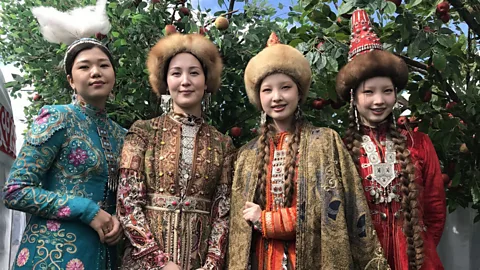 Bradley Mayhew
Bradley MayhewA celebration of nomadic culture
The World Nomad Games is about much more than simply sport. At the heart of the half-dozen sporting venues is the Ethno-aul (aul means village in Kazakh), a collection of yurts, craft shops and local restaurants where reenactors dress as medieval warriors and musicians and perform ancient folk songs.
Picture above, these women in traditional Kazakh dress stand in front of an apple tree in reference to the city’s claim to be the ancestral home of the wild apple; Almaty's Soviet-era name Alma-Ata means "Grandfather of Apples".
 Bradley Mayhew
Bradley MayhewMinstrels, music and epic poetry
One of the great joys of attending the World Nomad Games is the traditional music that pours out of the concert venues and yurts of the Ethno-aul complex. The most compelling Kazakh performers are its akim, bards or storytellers who recite and improvise epic poems and histories, while playing the dombra, a Kazakh-style lute.
More like this:
- Qurt: A Kazakh "cheese of resilience"
The musicians in the above photo are playing the dombra and accordion, the latter the legacy of the long Russian influence in the region.
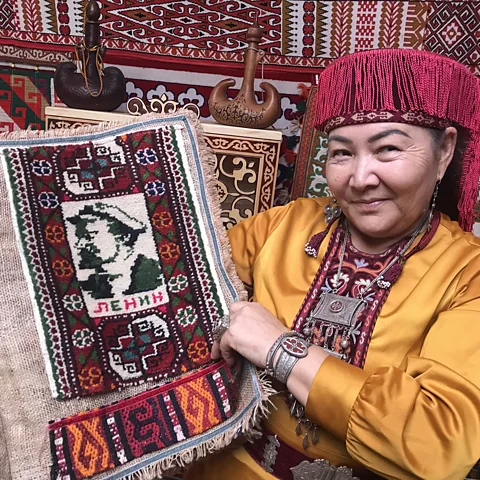 Bradley Mayhew
Bradley MayhewMaster crafts
Alongside sport and music, the World Nomad Fames aim to preserve artistic and textile traditions through its hosting of master craftspeople, many of whom offer displays and classes in traditional Kazakh handcrafts.
Bulbul Kapkyzy, pictured here with her Soviet-era Lenin carpet, is a master weaver, yurt maker and ethnographer who has been perfecting and teaching for more than 45 years. An ethnic Kazakh born in western Mongolia, she moved to Kazakhstan 20 years ago after independence, during a time of huge ethnic and economic upheaval in post-Soviet Central Asia.
 Getty Images
Getty ImagesKazakhstan's glittering city
Astana's ultra-modern architecture seems an unlikely location for a celebration of ancient nomadic culture.
Nomads have traditionally left little architectural legacy, and Kazakhstan's futuristic capital of Astana is quickly making up for lost time. Its well-funded, cutting-edge modern architectural projects by big names such as Norman Foster give it the feel of a Central Asian Dubai, even though its location on the great steppe means that it is the world's second coldest capital city (after Mongolia's Ulaanbaatar).
--
If you liked this story, sign up for The Essential List newsletter – a handpicked selection of features, videos and can't-miss news, delivered to your inbox twice a week.


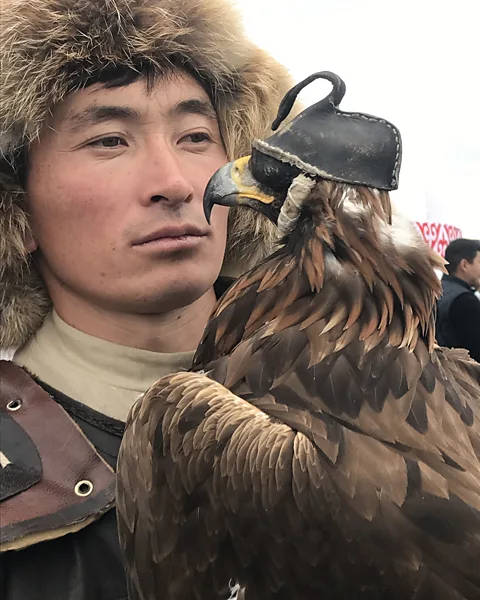
Post a Comment